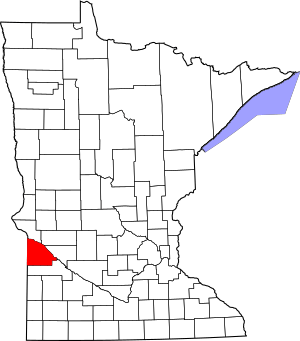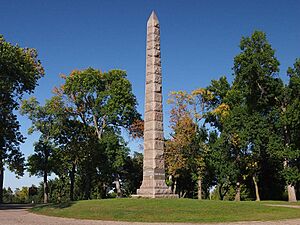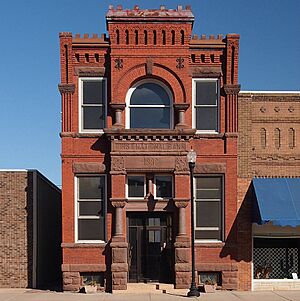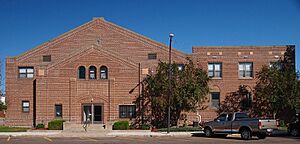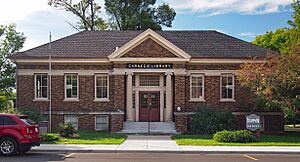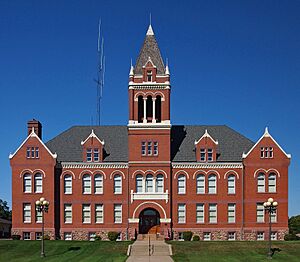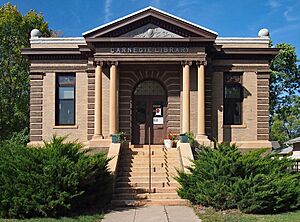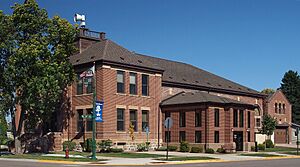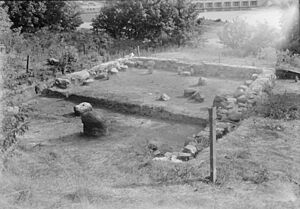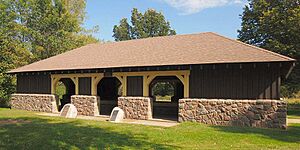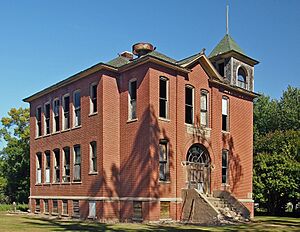National Register of Historic Places listings in Lac qui Parle County, Minnesota facts for kids
This article lists the special places in Lac qui Parle County, Minnesota, that are on the National Register of Historic Places. This register is like a special list of buildings, sites, and objects that are important in American history, architecture, archaeology, engineering, or culture. When a place is on this list, it means it's recognized as a valuable part of our country's past.
In Lac qui Parle County, there are 10 places currently on this important list. There were also three other sites that used to be on the list but are not anymore.
Contents
Historic Places You Can Visit
Here are some of the cool historic places in Lac qui Parle County that are on the National Register. Each one has a unique story!
Camp Release State Monument
The Camp Release State Monument is a special place located about two miles southwest of Montevideo. It marks the spot where a very important event happened at the end of the Dakota War of 1862. During this time, prisoners who had been taken by the Dakota people were set free here. It was also where the first military trials took place. A monument was put up in 1894 to remember this historic moment.
Dawson's Historic Buildings
Dawson is home to several buildings that tell stories of the past.
Commercial Bank Building
The Commercial Bank Building on 6th Street in Dawson is a great example of an old bank from the 1800s. It was built in 1892 for Christopher M. Anderson, who was a very important person in the early days of Lac qui Parle County and helped start the town of Dawson. The building has a special style called Richardsonian Romanesque, which means it has strong, rounded arches and heavy stone walls.
Dawson Armory and Community Building
The Dawson Armory and Community Building, located at 676 Pine Street, was built in 1923. An armory is a place where the Minnesota National Guard trains and stores equipment. This building was also a big part of Dawson's community life. It housed the city's offices and was the main place for meetings and events for many years. It shows how important these types of buildings were for both military readiness and town activities in the 1920s.
Dawson Carnegie Library
The Dawson Carnegie Library at 677 Pine Street is a beautiful building with a Neoclassical design. It was built between 1917 and 1918. This library is special because it was funded by the Carnegie Foundation. Andrew Carnegie was a very rich businessman who gave money to build thousands of libraries across the world, believing everyone should have access to books and learning. This library was designed by a local architect named A. H. Foss and has been an important part of Dawson's community since the public library started in the 1890s.
Madison's Important Buildings
Madison also has several historic buildings that are central to its history.
Lac qui Parle County Courthouse
The Lac qui Parle County Courthouse at 600 6th Street in Madison is a grand building from 1899. It was designed by famous architects Buechner & Jacobson. A courthouse is where important legal decisions and government business for the county happen. This building is a symbol of Madison's success in becoming the main county seat (the county's administrative center) after a long 17-year effort.
Madison Carnegie Library
The Madison Carnegie Library at 401 6th Avenue was built between 1905 and 1906. It's one of the earliest and most unique Carnegie libraries in west-central Minnesota because of its special design. It's also one of three large public buildings that make up Madison's distinct civic campus, showing how important public spaces were to the town.
Madison City Hall
The Madison City Hall at 404 6th Avenue is another Neoclassical building, designed by Buechner & Orth and built from 1902 to 1903. A city hall is where the local government operates. This building also served as an opera house, meaning it was a place for performances and social events. It has been a long-serving center for both government and community life in Madison, showing the town's plans for growth in the early 1900s.
Lac qui Parle Mission and State Park
These sites near Montevideo are important for understanding the region's early history and natural beauty.
Lac qui Parle Mission Archeological Historic District
This historic district is located near Montevideo and includes the sites of an old trading post called Fort Renville from 1826 and a mission church from 1841. A mission is a place where religious groups tried to teach and convert local people. The church was rebuilt in the 1940s. This area also has signs of where both Euro-American settlers and Dakota people lived, making it an important archaeological site that tells us about their interactions. Part of this district also extends into Chippewa County.
Lac qui Parle State Park WPA/Rustic Style Historic District
Lac qui Parle State Park, located off County Highway 33 near the southeastern end of Lac qui Parle, has three special park buildings constructed between 1938 and 1941. These buildings are important because they were built during the Great Depression as part of federal work relief programs like the New Deal. These programs provided jobs for many people. The buildings also show a style called National Park Service rustic architecture, which uses natural materials to blend in with the park's environment.
Louisburg School
The Louisburg School, found at 1st Street and 3rd Avenue in Louisburg, is a great example of a Victorian-style public school from west-central Minnesota. It was built in 1911. This school building represents the efforts of small communities in the state to provide good local school facilities for their children.
Places No Longer on the List
Sometimes, historic places are removed from the National Register. This usually happens if they are destroyed or moved.
Hotel Lac qui Parle
The Hotel Lac qui Parle was a hotel built in 1902 in Madison. Sadly, it was torn down in 1999, so it is no longer on the list.
Andreus Thoreson Farmhouse
This was an ornate farmhouse built in 1899 by Andreus Thoreson, an important early settler. Unfortunately, it burned down in an accidental fire in 1989 and was removed from the list in 1991.
Yellow Bank Church Campground Bridge
The Yellow Bank Church Campground Bridge was an old bridge from 1893 with a unique design. It was originally located over the Yellow Bank River near Odessa. In 1994, the bridge was moved to the Little Log House Pioneer Village outside Hastings, Minnesota. Because it was moved from its original location, it was removed from the National Register in 1998.


